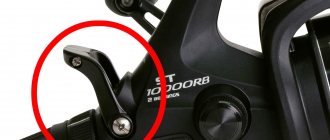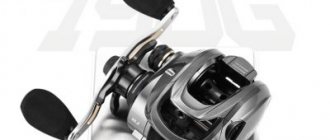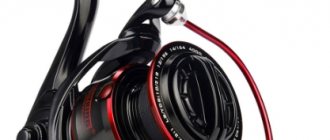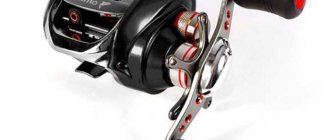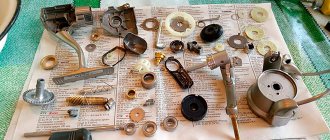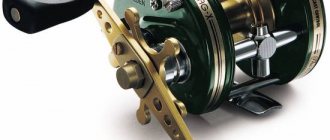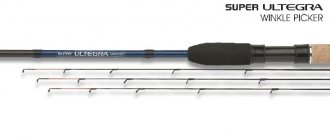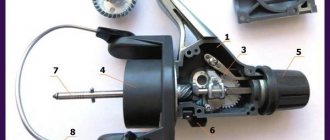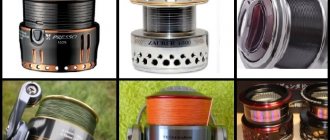In the last article, we talked with the repeated champion of Russia in spinning fishing, Evgeny Karasev, about how to choose the right spinning rod. Today we want to talk about how to choose a reel for a spinning rod.
Among the variety of types of spinning reels, you need to select them depending on the fishing method, as well as the fish you are going to fish for. When making long casts with heavy baits, you need a capacious reel, but for an ultralight rod, the reel should be light and not large in size so as not to unbalance the tackle.
Tips for choosing a spinning reel
On the shelves of fishing stores you can see a huge variety of spinning reels. The number of companies producing fishing reels number in the hundreds and each manufacturer has a large product range. Outwardly, they are all very similar to each other, and it will be quite difficult for an unprepared fisherman to make the right choice. In fact, everything is not so complicated, you just need to know what to look for when choosing a reel. The material from which it is made, as well as the design solution inside the reel itself, have a direct impact on the reliability and their technical characteristics.
The difficulty of choosing a spinning reel lies in many nuances, which we will discuss in more detail below. Knowing all the intricacies of both the device and the operation of the coil, the choice will be very simple.
Tips from professionals on choosing a reel
Consulting an experienced professional or a knowledgeable seller who can help you choose the right spinning equipment will help you avoid unnecessary expenses.A good fishing spinning reel should meet the preferences of the fisherman himself and match the type of bait used.
We choose a reel based on the following conditions: who will we catch, where and with what?
A big role in choosing a reel for a spinning rod is where you will fish, what kind of bait and what type of fish. For offshore fishing, a power reel with a large spool for winding a large amount of fishing line is suitable. When fishing on a river, where long casts are completely unnecessary and the fish are not large, you can use a small reel together with an ultralight rod. Depending on the weight of the bait and the casting distance, you should pay attention to the capacity of the reel spool, and, consequently, its size. When catching large fish, such as catfish or a number of other large predators, especially marine ones, preference should be given to power reels with a good margin of safety, which will allow you to restrain the fish at the time of hooking and at the time of desperate jerks of the predator.
At the same time, when fishing for relatively small fish, such as perch or river trout, you should choose a more delicate reel.
If we talk about the class of reels used on various fishing rods, then we can say that for ultra-light models of spinning rods they use 500 class reels weighing up to 170 grams. Class from 1000 to 1500 is used, as a rule, in light models of spinning rods with a length of 2.7-3.5 meters. Class 2000 is universal and the most common, suitable for medium action spinning rods. Class 3000-4000 is used for feeder rods, but for the largest fish, class 4500 reels are used.
Basic parameters when choosing a spinning reel
Materials used in reels
The main materials used in the manufacture of spinning reels are metal and plastic. Moreover, there are hundreds of varieties of both the first and second materials, differing in their performance properties.
Combinations of these materials are very often used in reels. For example, the body is made of durable plastic or light metal alloys such as titanium or duralumin, the spool is made of aluminum alloys or plastic. The line handle is made of composite materials or stainless steel, etc. Despite the fact that various materials are used in reels, there are models where only plastic or only metal is used. The durability of all-metal reels is an order of magnitude higher, but they lose in sensitivity when biting, and also cost much more than their competitors.
By improving the technical characteristics of reels, manufacturers are constantly updating their model line. Achieving greater strength in structural units, manufacturers are trying to reduce the weight of the structure. The cost of such reels is not small, but it justifies itself when fighting fish. The most common reels are those with a carbon fiber body due to their strength and relatively low price. It must be said that modern carbon fiber is in many ways superior to various types of metals.
When choosing a spinning reel, you should not blindly succumb to the principle that the more expensive the better, you should read what materials it is made of, and only then make a purchasing decision. Although, as practice shows, the price directly depends on the quality of the fishing reel.
Gear ratio of spinning reel
The gear ratio of a spinning reel is the ratio of one full revolution of the handle to the number of revolutions of the line guide. Based on this definition, all coils can be divided into 2 types:
- power
- expressways
The ratio of these revolutions is indicated directly on the reel in the form of 5.0:1 or 5.3:1 - this means that one revolution of the reel handle corresponds to 5 (5.3) revolutions of the line guide. The higher the first value, the faster the coil is and vice versa, if this value is lower, then the coil is more powerful.
Reels with a gear ratio of 5.0 or less are usually called power, and those with a gear ratio greater than 5.0 are called high-speed.
The value of these coefficients depends on the pitch of the gear teeth. In simple terms, power reels are designed for catching large fish, such as catfish or a number of other marine fish, and high-speed ones are for more delicate fishing, for example, with jig baits or small wobblers.
A ratio of 5.0 is the golden mean between these reels, so if you don't know what kind of fish you'll be catching tomorrow, opt for versatility.
Dimensions and weight of coils
With the release of each new model of fishing reel, manufacturers try to reduce its weight while maintaining all other technical characteristics, and often improving them too. This is done to make fishing more comfortable, and the emotions from using such equipment brighter. The weight of the reel directly affects the balance of the spinning rod. There is an unspoken rule among professionals that the weight of the reel should be twice as heavy as the weight of the rod. Of course, it should not be taken as a postulate and followed unconditionally, but as practice shows, it is very suitable for most cases when equipping a spinning rod.
All reels are numbered by manufacturers, but there is still no uniform classification, so if on the store counter you see two completely different in appearance, but with the same reel markings, keep in mind, this is exactly the case. Spinning reels are marked as follows: 500, 1000, 2000, 2500, 3000 and 4000.
It is worth saying that the classification of reels proposed by Shimano has found its approval among other manufacturers of this equipment and they also use it.
To correctly select a reel for a fishing rod, you need to take into account at least two parameters: the test of the rod and its length. Based on these considerations, below we provide a table for selecting a reel for a fishing rod, which connects the technical parameters of a spinning rod with the size of the reel.
| Rod length, cm | Rod test, g | Line diameter, mm | Shimano number size |
| Up to 180 | Up to 5 | 0,10-0,12 | 500 |
| 5-15 | 0,12-0,14 | 500-1000 | |
| 20-40 | 0,18-0,22 | 2000-3000 | |
| Up to 210 | Up to 5 | 0,12-0,14 | 500-1000 |
| 5-15 | 0,16-0,2 | 1000 | |
| 15- 40 | 0,2-0,25 | 2000-2500 | |
| Up to 240 | Up to 15 | 0,12-0,14 | 1000 |
| 15-30 | 0,25 | 2000-2500 | |
| 30-50 | 0,25-0,28 | 2500 | |
| Up to 270 | Up to 15 | 0,12-0,14 | 1000 |
| 15-30 | 0,18-0,22 | 2000 | |
| 30-50 | 0,25-0,28 | 2500 -4000 | |
| Up to 300 | To 10 | 0,12-0,14 | 1000 |
| 10-25 | 0,18-0,22 | 1000-2000 | |
| 20-40 | 0,3-0,35 | 2500-3000 | |
| 40-70 | 0,32-0,45 | 3000-4000 |
In other words, if you have a rod 240 cm long with a test of 10-30 grams, then based on the table above, a reel of size 2000-2500 will be most suitable
| Rod length, cm | Rod test, g | Line diameter, mm | Shimano number size |
| Up to 240 | 15-30 | 0,25 | 2000-2500 |
Smooth ride
The smooth running of the reel directly affects the sensitivity of the bait, as well as the uniformity of winding the fishing line onto the spool. With a poorly spooled line, the casting range will decrease, and the action of the bait will look twitchy and unreliable, which will affect the number of bites and, as a result, the fish caught.
The main elements that you should pay attention to when choosing a spinning reel:
Spinning reels are a complex mechanism consisting of several components assembled into a single whole. Therefore, the operation of the entire mechanism depends on each element separately. Let's take a closer look at the main elements of a fishing reel that you need to pay attention to when choosing one.
Spool
A spool is an element of a spinning reel designed to store fishing line. Spools are produced in both metal and plastic. The most common are metal spools, as they are more versatile and suitable for both braid and monofilament lines, while the plastic spool is used only with monofilament lines. Refusal to use braided cords in plastic spools is due to the fact that over time the side of the spool wears down and leads to cord breakage. Moreover, the quality of the plastic does not greatly affect this, but only increases the delay in spool wear, and as a result, the rapid breakage of the cord.
They also differ in the capacity of the reeled fishing line. On each spool there is written the length of fishing line that fits on it of a certain diameter. The parameters indicated on the spool apply only to fishing line and do not apply to braided cord.
Another indicator of the spool is the ratio of its depth to width. In classical variants this ratio is equal to one. For Long Cast spools, this ratio is less than one, in other words, its length is increased compared to its depth.
The main advantage of spools is their casting range. Some manufacturers make reel designs in such a way that it can accommodate spools of various geometries, both “classic” and Long Cast. Therefore, by changing the spool, we can actually get a size 2000 reel from a size 1500 and vice versa.
Many manufacturers immediately equip reels with interchangeable spools, this is very convenient; you can wind fishing line on one of them, and braided cord on the other. While fishing, changing these spools will give your gear versatility. There is no need to carry two spinning rods with you at the same time for different fishing methods. Since a cord is better for jig fishing, but a fishing line is better for spinners and various spinners. At the same time, a spare reel will save you if the fishing line suddenly breaks; a quick spool change will allow you to continue fishing.
If you are unlucky and your reel does not have a replacement spool, then it does not matter: you can always purchase it at any fishing store, but you must understand that not every spool fits a specific reel model, so if you go to buy a new spool, take it with you reel for good measure.
Bearings
Many people have probably heard how scrupulous experienced fishermen are about such a parameter as the number of bearings when choosing a spinning reel. After all, the durability and performance of the reel directly depends on the quantity and quality of bearings. However, there must be a balance in their quantity, and having a large number of them does not mean the quality of the reel.
Each reel has several ball bearings and one (central) roller bearing. On some reels it is written like this: 4+1, 6+1 or 8+1. It is believed that the more bearings, the better the smooth running, and therefore the less wear, this applies to top-end, expensive models. In most cases, a large number of bearings is a marketing ploy.
For beginner spinners, a 4+1 reel with four ball and one roller bearings is suitable.
Reel handle
There are several options for the location of the reel handle:
- permanently installed on the right;
- permanently installed on the left;
- interchangeable arrangement: both on the left and on the right, depending on who is more comfortable.
The last option is the most common, although the first two options are not uncommon, so be careful when buying a reel: on which side the handle is located.
If we talk about the shape of the handle, then there are hundreds of their varieties, both in terms of ergonomics and different materials: and here it is pointless to give advice, since everyone chooses for themselves what is more convenient for them. The only thing worth paying attention to is how the handle folds into the transport position. The best option for bringing the handle into the working position is to unscrew the screw; all other mechanisms, such as latches, begin to give play over time due to wear.
Line handle
It seemed that such a small and insignificant element of the reel as the line guide should not deserve attention, but there are several very important points:
- he must carefully and evenly lay the line on the spool;
- when opening the bow, it should not spontaneously return back;
- There should be no gaps between the roller and the bow itself, otherwise you risk breaking the line if it gets into the gap and losing the bait.
Friction brake
The mechanism by which the fishing line is released at the moment of a strong jerk caused by a fish bite or a hook is called a friction clutch. Thanks to this device, the likelihood of line breakage is reduced to zero with the right setup. The number of fish failures or gear breaks will depend on the correct operation of the clutch. It should be smoothly adjustable and have an anti-lock feature. The presence of such a function in the clutch allows you to release the line even with the brake tightened to the maximum, but with greater force. This function is very useful in cases when a fisherman forgets to adjust the clutch and when a large fish bites, the fishing line is released. In the absence of such a function, the fisherman runs the risk of breaking the tackle or breaking the fishing line.
Physically, the clutch can be located either in front of the reel or behind it. From the technical side there is no difference, but from the point of view of ease of use, everyone decides for themselves. But if you are used to using the clutch at the rear, it will be very difficult to relearn.
How to choose a reel for a feeder
Based on the requirements, feeder coils are endowed with certain functionality and differ from other types and types of devices in their design features. Some design features are detected visually, the presence of others can only be judged from the technical description of the product.
Many parameters of inertialess mechanisms are indicated in the form of markings with alphabetic and numerical signs directly on the body of the product or on its spool. Information about the features of servicing transmission boxes can be found on the packaging or in product passports. The same applies to warranty periods, which indicate the duration of uninterrupted and reliable operation of the meat grinder.
By the way, any real reel, not plagiarized or fake, will definitely be sold to the buyer with a warranty. Otherwise, you can immediately talk about a counterfeit product. Therefore, one way or another, you should have information about the possible performance qualities of the product, and this will be the subject of our further conversation, which will tell in more detail about the principles of selecting one of the significant elements of feeder gear that contributes to the reliability and comfort of fishing.
Manufacturer
Of course, in the global market for fishing products of this type there are unlikely to be serious competitors to Japanese brands. Mass production of high-quality spinning rods is the specialty of the Japanese fishing industry, where the flagships are such companies as Daiwa, Shimano, Ryobi, Kosadaka and Mikado . Brands produce not only elite products with high prices, but also in their lines you can find mid-budget products with high performance parameters. Perhaps, in the vastness of our country, the mechanisms of these companies are the most widespread.
In addition to the Japanese, the Swedish brand Abu Garcia has good reviews. Swedish products cannot be called budget feeder reels, but the investment is justified by the durability and reliability of the product. The German manufacturer of inertialess motors Balzer is quite good in operation. English companies, for example, Mitchell, are distinguished by the quality of reels similar to those of the Japanese, but many fishermen cannot afford the price parameter of such elite products. Therefore, although these are the best feeder reels, they have not gained mass popularity among our fishermen.
Among domestic manufacturers, we note the products of the Volzhanka and Stinger companies. Feeders are attracted to these products by the low price and relatively good quality of the products. By choosing a spinning gear from the companies presented, you are guaranteed to receive an element of feeder gear that can last for more than one intensive fishing season, even without a hint of loss of reliability on the part of the mechanism.
Coil size
As is known to anglers, the feeder reel, or rather its size, is indicated by a digital value on the spool indicating its size range. The value is usually expressed in thousands of units. The value characterizes the capacity of the spool, and as practice has shown, it is by this value that it is most convenient to judge the size of the spinning gear. Depending on the power of the feeder tackle, a meat grinder of suitable size is equipped with the form.
Light picker-type feeders are usually equipped with the smallest, in terms of feeder devices, the size of which is 2500–3000 units. The average level of feeder gear is supplied with meat grinders measuring 3500–4000 units. Heavy and super-heavy fishing rods in the English donkey are equipped with massive, powerful mechanisms with a size of 5000–6000 units, and under certain conditions, inertia-free spool parameters with even larger parameters. As can be seen from the information presented above, the multiplicity of the designation is graded through a parameter of 500 units.
Number of bearings
Bearings play an important role in the design of inertialess motors. After all, the design of the device includes a lot of joints, the operation of which is based on the principles of rotation and rolling. Smooth running and reduced friction forces in places that are articulated to transmit rotational movements are ensured by the presence of a bearing. At first glance, one gets the impression that the more bearings there are in a reel, the more practical and reliable it is in operation. But in reality this is not the case at all.
Too much bearings increases the weight of the device, making it bulky and expensive to maintain. In addition, the failure of even one bearing is fraught with the complete cessation of operation of the entire mechanism, which, of course, does not even come close to the concept of a highly reliable product. As a rule, the optimal number of bearings in the process of choosing a reel for a feeder is 5–6 units, no more. In practice, you can find a product with 15 bearings, which, of course, is not worth going for, even if this reel falls under the concept of inexpensive.
Gear ratio
The gear ratio indicates the speed parameters of the device. This value is the ratio between the amount of rotation of the handle and the amount of rotation of the spool on the mechanism. Each model of the product has different ratios and the higher it is, the faster the main cord is reeled out. This parameter can often be determined by numerical markings on the product spool printed in the form of fractional numbers such as 5:1 or 4.6:1.
For feeder fishing, they prefer to use power reels with ratios lower than 4:1. High-speed devices, as a rule, have less traction and are not entirely suitable for reeling in heavy rigs, where feeders that are quite heavy in weight can be used. And speed when hunting with a feeder in most cases does not solve the main problems of fishing. After all, the dynamics of fishing with an English donkey are much lower than the spinning direction, and in some cases even the match.
Important! As a rule, it is recommended to adhere to the principle that the more powerful the rod itself, the more powerful the device included in the feeder.
Thus, following the practical experience of experienced feeders, you can choose a feeder reel that perfectly balances the tackle.
Spool geometry
The geometry of the spool has a significant impact on the long-range performance of the feeder gun. There are three types of geometric shapes, namely cylindrical, straight and reverse cone. Often, anglers, and especially if the feeder is a beginner, confuse the parameters of the spool geometry with the type of line laid in the drum. After all, these are identical in name, but different in essence concepts. In reality, each geometric profile, depending on the design of the mechanism, can wind the cord using a different type of laying.
Spools with a straight cone release the line more freely when casting, thus increasing the casting distance. On the contrary, types with a reverse cone are suitable for fishing at short and medium distances. Cylindrical-shaped spools are more versatile and popular in sales, and it is these types that are especially popular in classic feeder fishing. When wound onto an ordinary cylinder, the thread lies evenly, equally reflecting the configuration of the bobbin on the formed winding.
Important! Regardless of the geometry of the drum, the cord is not wound to the edge of the spool by 2-2.5 mm.
This technique eliminates the spontaneous coming off of rings and the formation of beards during casting.
Coil weight
As we have already mentioned, the dynamism of feeder fishing and its mobility are lower than the average levels of classical spinning fishing, therefore the requirements for the masses of the device are liberal and the principle of searching for the lightest versions of the product is not different. Often, the functionality of a meat grinder seriously affects its final weight, especially if the product is equipped with such an element as a bayrunner. Ensuring the reliability of the feed mechanism cannot be achieved with plastic materials, the presence of which is inherent in fakes.
In traction coils, gears, shafts and bearings are made of high-strength metal alloys, which determines the final high weight. And it is easier to achieve waterproofness of the case and, in general, its tightness from fine dust by using corrosion-resistant steel alloys, which also does not make the device lighter. On average, the weights of feeder reels range from 250 to 400 grams, and in retail outlets you can also find 700-gram devices for super-heavy equipment.
Friction brake
It is impossible to imagine a modern inertia-free vehicle without a friction brake. This is a mandatory attribute of the device functionality. Even the cheapest, counterfeit mechanisms are equipped with this design, which regulates the amount of drum braking. The friction brake system helps prevent breakage of the main line of the equipment in the process of fishing for large fish or a hook while reeling in the line.
At the maximum load on the thread, the friction brake design is activated, allowing the spool to rotate freely, thereby preserving both the equipment and the fished trophy. The clutch is adjusted using a clamping screw or a handle, the location of which varies both from the front of the mechanism and from its back.
Important! The force to operate the brake is set to the desired parameter, but to a value not exceeding the breaking force of the cord.
Otherwise, if overloaded, the line will not withstand the tension and a rupture will occur with the loss of the trophy. Drawing a conclusion, it can be noted that the friction brake can rightfully be considered a kind of fuse that keeps the cord intact.
Availability of a buyrunner
The function of a baitrunner, unlike a clutch, is not inherent in all mechanisms. As a rule, this is the privilege of feeder power reels, aimed at assembling a set of tools for catching trophy fish such as carp, grass carp, carp and silver carp. What saves a baitrunner from loss is not the cord, but the tackle itself. In addition, this is a convenient function that allows you to leave the fishing gear unattended in a working, charged and installed state, without fear of it being pulled into the water by powerful fish.
The baitrunner lever is located in the rear part of the housing and has two positions for turning off and turning on. When biting with the baitrunner turned on, the spool freely gives up the line, allowing the fish to move back to the distance of the line reserve. Having noticed the line coming off, the fisherman can only turn off the baitrunner, after which the brake functions are transferred to the clutch, and begin to land fish. Of course, all the best feeder reels are additionally equipped with this function, but it is worth considering that the cost of such devices is significantly higher than the price of a classic meat grinder.
Spinning reel brands
If you look at the shelves of any fishing store, you can see reels produced by dozens and even hundreds of manufacturers, how can a novice fisherman not get confused. In fact, not everything is so complicated; among the dominance of unknown Asian manufacturers, the leaders in the fishing reel production market remain: the Japanese company Shimano and their direct competitor Daiwa, also from Japan. The competitive struggle between these manufacturers allowed them to confidently overtake other competitors.
It should be noted that other manufacturers have also greatly succeeded in the production of reels, achieving good technical characteristics while maintaining affordable prices.
Among such manufacturers are the Latvian Salmo, the American Zebco, the Chinese Okuma, SPRO - Holland, Abu Garcia - Sweden, Ryobi - Japan, Mitchell - France.
In this article, we tried to tell you in as much detail as possible about all the features and various nuances when choosing a fishing reel. All you have to do is put this knowledge into practice and choose a reel made from durable materials from a trusted manufacturer.
uralfish.ru
